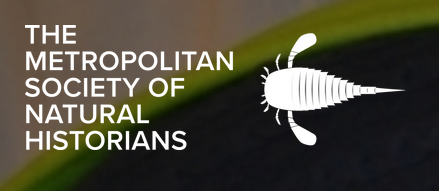In the afternoon on Sunday, February 19th, members ofThe Metropolitan Society of Natural Historians were taken on a fossil tour at the American Natural History Museum (AMHH) with Amelia Zietlow, a Ph.D. student at the Richard Gilder Graduate School of the AMNH. Amelia led us back in time to learn about the amazing animals that once roamed the Earth as well as the evolutionary origins of the creatures we know today. It was a big group of enthusiastic and engaged learners, so the museum provided us with earphones, so we could all hear what Amelia was saying, even if stuck behind a Lestodon (a giant ground sloth) or Velociraptor.
Beginning in the Hall of Ornithischian Dinosaurs, meaning “bird-hipped,” characterized by backward-pointed pubis bones, Amelia told us about how it’s thought this hip structure supported their need to digest large quantities of vegetation. This group includes fossils of the famed Triceratops and Stegosaurus, as well as members of the lesser-known group of hadrosaurids, the duck-billed dinosaurs, which possessed hundreds of interlocking stacked columns of complex teeth reflecting adaptations to grinding tough plant material with incredible efficiency. MSNH members learned about the different methods of displaying fossils: mounted in three dimensions, so scientists and the public alike can see how the bones would have fit together in the living organism; or flat packed in plaster, which saves space and can help to protect fragile fossils, but often fails to provide a complete picture.
We also visited the Hall of the Saurischian Dinosaurs, the “lizard-hipped” dinosaurs with forward-pointed pubis bones that are similar to modern lizards. Theropods are bipedal carnivorous members of this group and include the absolutely massive Titanosaur (a sauropod), Tyrannosaurus rex, and the Maniraptora which includes modern birds.
In the Paul and Irma Milstein Hall of Advanced Mammals, Amelia took us to what she considered to be one of the most special specimens in the museum, the mummified remains of a baby Woolly Mammoth named Effie, who was born over 20,000 years ago in Alaska.
In the Hall of Vertebrate Origins, Amelia showed us fossils of mammalian ancestors, pointing out our relationship to fish and describing important transitions that can be observed in the fossils at the museum including a backbone, lungs, and complex ears that evolved via co-opting some of the lower jaw bones. Here we made a special stop at the impressive fossil of Tylosaurus, one of the largest of an ancient group of marine reptiles called mosasaurs, and one of Amelia’s focal study organisms. She told us how this once dominant group of predators, sometimes more than 13 meters long (Jaws would have nothing on them!), were viviparous, meaning that they gave birth to live young out at sea.
Thanks to Amelia, we all returned to our homes with a deeper appreciation and understanding of the organisms that came before us and the important work that the AMNH and researchers such like her are doing. A special shout out to Russell Taragan from the AMNH’s Volunteer Office for providing us with headphones!
To view more photos from this event, visit our gallery. All photo credit goes to Glenn Doherty and the writeup for this event was provided by Elise Morton.
Amelia Zietlow is from Milwaukee, Wisconsin. She completed her B.A. in Biology at Carthage College in Kenosha, WI, where she wrote her honors thesis on the development and evolution of the mosasaur Tylosaurus, which was later published in PeerJ in 2020. During her undergrad, she spent two summers (one of which was funded by the National Science Foundation Research Experience for Undergraduates program) at Marquette University in Milwaukee, where she worked on several projects studying embryological development in modern geckos. Currently, she is a third year Ph.D. Candidate at the Richard Gilder Graduate School at AMNH. Her dissertation research focuses on the anatomy and evolution of mosasaurs, a group of extinct marine lizards, and their living relatives.



